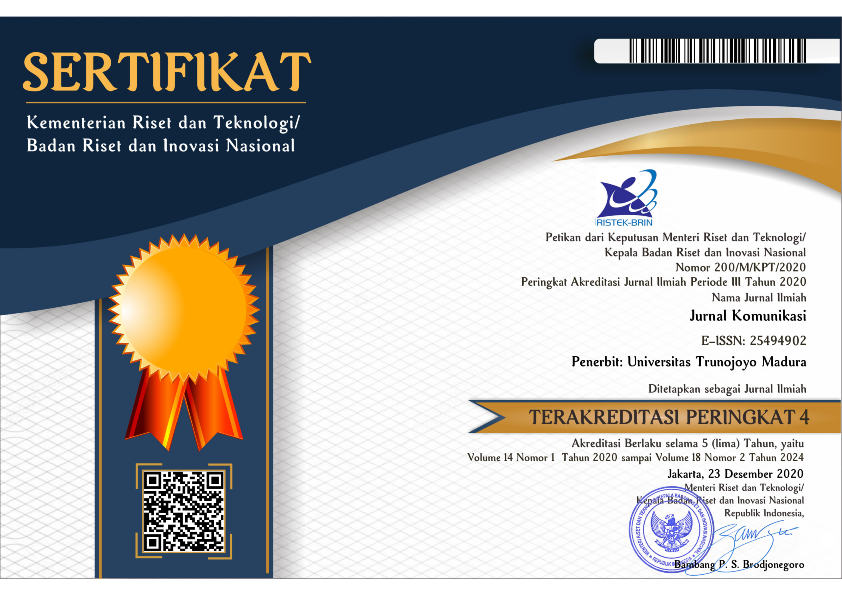Teori Manajemen Identitas: Kajian tentang Faceworks dalam Hubungan antar Budaya
Abstract
Teori Manajemen Identitas (TMI) memberikan kontribusi terhadap pemahaman mengenai kompetensi komunikasi antar budaya dengan cara mengklarifikasikan hubungan antara manajemen identitas dengan strategi tatap muka, Prinsip dari teori ini memperoleh dukungan dari beberapa hasil penelitian dan memiliki ketahanan yang baik terhadap kritik-kritik. Teori Manajemen Identitas (TMI) disusun dalam kerangka kerja heuristis untuk membantu memahami kerumitan / kompleksitas dari manajemen identitas dalam kaitannya dengan interaksi antar budaya. Meskipun TMI tidak disusun dalam bentuk preskriptif 'berbentuk ketentuan', Teori Manajemen Identitas (TMI) menyajikan beberapa prinsip terhadap perkembangan kompetensi komunikasi pada pasangan antar budaya, yaitu (a) Menentukan hubungan identitas melalui peningkatan coactions,konvergensi simbolik, dan koordinasi suatu hubungan dari aturan-aturan , (b) Memandang perbedaan budaya sebagai aset bukan hambatan, dan (c) mengetahui bahwa manajemen identitas dan hubungan 'relasi' dapat dianalogikan seperti dua sisi uang logam.
Keywords
Full Text:
PDF (Bahasa Indonesia)References
Baxter, L . A. (1987). Symbols of relationship identity in relationship cultures. journal of Social and Personal Relationships, 4
Brown, P., & Levinson, S. (1 978). Universals in language usage: Politeness phenomena. In E. N. Goody ( Ed.), Questions and politeness. Cambridge, UK: Cambridge University Press.
Collier, M. J., & Thomas, M. (1988). Cultural identity: An interpretive perspective. In Y. Y. Kim & W. B. Gudykunst ( Eds.), Theories in intercultural communication (pp. 94-120). Newbury Park, CA: Sage.
Cupach, W. R., & lmahori, T. T. (1 989, November). Intercultural communication competence: Culture-general, culture-specific, and culture-synergistic. Paper presented at the annual meeting of the Speech Communication Association, San Francisco.
Cupach, W. R., & Metts, S. (1994). Facework. Thousand Oaks, CA: Sage. Duck, S. ( 1 991, May). New lamps for old: A new theory of relationships and a fresh look at some old research. Paper presented at the Third Annual Conference of the International Network on Personal Relationships, Normal/ Bloomington, IL.
Goffman, E. ( 1 959). The presentation of self in everyday life. Garden City, NY: Anchor.
Goffman, E. ( 1 967). Interaction ritual: Essays on face to face behavior. Garden City, NY: Anchor.
Gudykunst, W. B. (1993). Toward a theory of effective interpersonal and intergroup commu• nication: An anxiety/uncertainty management (AUM) perspective. In R. L. Wiseman & ]. Koester (Eds.), Intercultural communication competence (pp. 33-71). Newbury Park, CA: Sage
Gudykunst, W. B. (1995). Anxiety/uncertainty management (AUM) theory: Current status. In R. L. Wiseman (Ed.), Intercultural communication theory (pp. 8-58). Thousand Oaks, CA: Sage. Hecht, M. L., Collier, M. ]., & Ribeau, S. ( 1 993). African American communication: Ethnic identity and cultural interpretation. Newbury Park, CA: Sage.
Hecht, M. L., Larkey, L. K., & Johnson,]. N. (1992). African American and European American perceptions of problematic issues in interethnic communication effectiveness. Human Communication Research
Hecht, M. L., Ribeau, S., & Alberts, J. K. (I 989). An Afro-American perspective on interethnic communication. Communication Monographs
Imahori, T. T. (2002, November). Facework strategies for identity management in real intercultural relationships: An extensive interview study. Paper presented at the annual meeting of the National Communication Association, New Orleans.
Imahori, T. T., & Lanigan, M. (1989). Relational model of intercultural communication competence. Intemational journal of Intercultural Relations, 13
Merrigan, G. (2000). Negotiating personal identities among people with and without identified disabilities: The role of identity management. In D. 0. Braithwaite & T. L.
Thompson (Eds .), Handbook of communication and people with disabilities: Research and application
Stets, J. E., & Burke, P. J. (2000). Identity theory and social identity theory. Social Psychology Quarterly, 63
Tajfel, H., & Turner, ]. C. (1 979). An integrative theory of intergroup conflict. In W. G. Austin & S. Worchel (Eds.), The social psychology of intergroup relations ,Monterey, CA: Brooks-Cole.
.
Ting-Toomey, S. ( 1993). Communicative resourcefulness: An identity negotiation perspective. In R. L. Wiseman & ]. Koester (Eds.), Intercultural communication competence (pp. 72-1 1 1). Newbury Park, CA: Sage.
Weinstein, E. A., & Deutschberger, P. ( 1963). Some dimensions of altercasting. Sociometry, 4
Wiseman, R. L. (2002). Intercultural communication competence. In W. B. Gudykunst & B. Mody (Eds.), Handbook of international and intercultural communication (2nd ed., pp. 207-224). Thousand Oaks, CA: Sage. Wood, ]. T. (1982). Communication and relational culture: Bases for the study of human relationships. Communication Quarterly
DOI: https://doi.org/10.21107/ilkom.v14i1.7171
Refbacks
- There are currently no refbacks.
Copyright (c) 2020 Nikmah Suryandari

This work is licensed under a Creative Commons Attribution-ShareAlike 4.0 International License.
Jurnal Komunikasi by Universitas Trunojoyo Madura is licensed under a Creative Commons Attribution-ShareAlike 4.0 International License.















